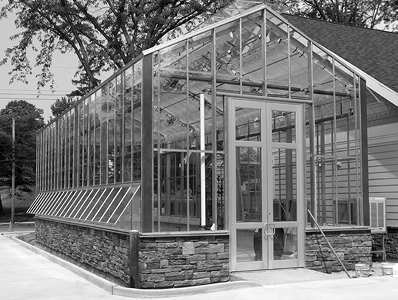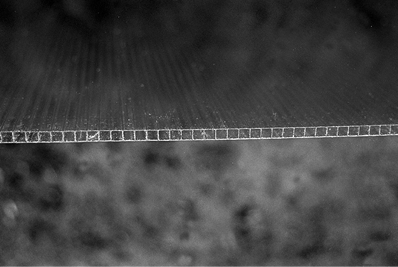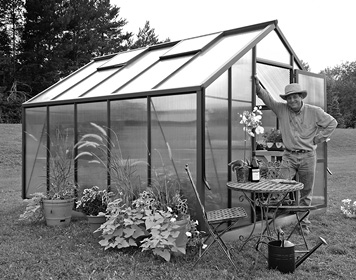“Gardening requires lots of water — most of it in the form of perspiration.”
— Lou Erickson, American writer
In the previous chapters, you learned all the ways that you can build your beloved greenhouse and briefly discussed the materials you can use to cover your greenhouse. In this chapter, you are going to learn the detailed process of covering your greenhouse and all of the materials necessary for such a venture. The type of covering you choose will depend on a number of factors including how much money you have, your ability to work with the coverings, and the climate in which you live.
Glass
Glass is a very beautiful option for your greenhouse because it is the highest quality, but it is also the highest priced option for your building project. In addition, it is the heaviest material for the greenhouse siding, as well as the most difficult for you to install.
When you install glass, it needs to be double or triple-strength glass in order to withstand the elements, and needs to have a sturdy frame. Another downside to glass is heating, as sunlight that filters through the glass can become more intense and burn plants in some cases.
Now, it may seem like there are several problems with glass for a greenhouse but glass has benefits as well. First, glass can protect plants from harmful UV radiation, and when there is a blizzard or dust storm, your plants should be thoroughly protected. Insects have a very difficult time getting into glass greenhouses, which can greatly reduce your need for pest control. Additionally, as previously mentioned, you can greatly raise the temperature of the greenhouse by using glass, thereby increasing the length of your growing season.

This is an example of an all-glass greenhouse.
Photo courtesy of Rough Brothers, Inc.
You can get greenhouse glass in a variety of sizes including as large as the entire wall of the greenhouse. Smaller glass panes will have more strength, but you will need to have more framing for all the glass. Larger glass panes are weaker, but you spend less on the framing.
When you are thinking of buying glass for your greenhouse, these are some things that you should keep in mind:
• Make sure you check out some offers to ensure you buy something that is durable enough to hold up under harsh weather conditions and is of high quality.
• Always make sure that the greenhouse glass is being attached to a frame of galvanized steel. Galvanized steel is very good at blocking excessive ultraviolet rays.
• Assess the particular plants you intend to grow in your glass greenhouse. Greenhouse glass is very good for seasonal plants, in terms of helping them grow. If you are growing many seasonal plants, then glass may be a good option for you.
Polycarbonate
Polycarbonate as a way of covering your greenhouse is becoming extremely popular with more and more greenhouse enthusiasts working to install polycarbonate instead of glass for their greenhouse. Glass greenhouses are great, but some of the problems with them, including shattering and condensation, are eliminated with polycarbonate. Polycarbonate is great at insulating a greenhouse and keeping the inside temperature of the greenhouse at a constant temperature. During cooler seasons, this means there is less energy needed to heat the greenhouse when the temperature is cool.

Here is a close-up view of polycarbonate.
Photo courtesy of Rough Brothers, Inc.
One amazing benefit that comes from polycarbonate is the fact that the corrugated surface of polycarbonate helps to refract light better, thereby giving your plants and vegetation the optimum daylight they need. Compared with glass, polycarbonate is also much lighter, making it easy to construct and work with, and less likely to be damaged during transportation.
Some other advantages with polycarbonate include:
• Polycarbonate helps to create an atmosphere within the greenhouse that aids growing, thanks to constant temperatures, maximum sunlight, and a barrier against wind, rain, and snow.
• Polycarbonate is nearly indestructible and can withstand being hit by hail stones, baseballs, and even rocks.
• Polycarbonate comes in many different sizes and shapes to help you customize the covering for the greenhouse in any way that you need to.

This is an example of a greenhouse made out of polycarbonate.
Photo courtesy of Rough Brothers, Inc.
Acrylic
Acrylic is a clear plastic that resembles glass but in many ways is superior to it. There are two types of acrylic that you can use: extruded and cell cast. Extruded acrylic is made through a process that is less expensive, but unfortunately it is softer than glass and polycarbonate and also scratches easier. Cell cast acrylic is higher quality and is a great choice if you have the money to pay for it. It does not scratch easily and it will stand up to more abuse, which is important if you live in an area where there is severe weather during certain seasons of the year.
Acrylic is heavier than typical plastics but it is only half as heavy as glass, which makes working with it very easy. You can saw it without a problem, making it easier to put onto a greenhouse than glass.
One of the biggest misconceptions about acrylic is that it turns yellow, cracks, and becomes brittle over time. During World War II, this was true in many fighter planes that had bubble-tops made of acrylic, but since then the process of making acrylic has become much more advanced. Nowadays, the acrylic is much better produced and you do not need to worry about it yellowing or breaking suddenly.
As with anything, there are some disadvantages to acrylic and these include the fact that it is more expensive than glass and if there is a direct flame on the acrylic, it will melt and burn. Acrylic will get dirty so you will need to clean it. Detergent and water work well and you will only need to clean about once per year unless you are in an area that has dust storms on a regular basis.
The advantages of using acrylic include:
• It is lightweight and easier to move than glass; therefore, installing it should not be a problem.
• Sunlight filters better through acrylic panels, which creates the perfect conditions for your plants to flourish.
• It is virtually shatter-proof, unlike glass. This allows you a worry free environment to grow healthy plant life.
Fiberglass
Fiberglass is lightweight, it is strong, and it can stand up to hail. This is very important if you live somewhere that has many storms. Hail can break glass, but it will not break fiberglass, which is very important because you do not want to replace it on a regular basis. Typically, fiberglass will last about 15 to 20 years and you will need to put a new coat of resin every decade or so to help keep the fiberglass working properly. If you are going to get fiberglass for your greenhouse, then you should make sure it is clear and made for greenhouses. There is some fiberglass that does not allow much sunlight through, which defeats the purpose of using it in a greenhouse.
Fiberglass is very rigid and will cost you less than glass. It also does not need heavy and extensive structural components, as you would find with a glass greenhouse. However, a disadvantage with fiberglass is that it breaks down under UV light, which is why you need to coat resin over it every decade. Lower grades of fiberglass will need resin about every five years.
Some advantages to using fiberglass include:
• Fiberglass, like glass, will create a greenhouse that is shadow-less, which ensures that all of your plants in the greenhouse get light.
• Fiberglass will also retain more heat than glass does, which will aid your greenhouse in maintaining a constant temperature.
Plastic Film
Plastic is probably the cheapest type of covering you can get but that does not mean it is not going to work for you. Plastic creates a warm and suitable environment for your plants. With plastic film over your greenhouse, you can help protect your greenhouse plants from ultraviolet rays, while still getting natural heat and light within the greenhouse.
There are primarily three types of plastic film that you can get for your greenhouse covering — PVC, polyvinyl chloride, and polyethylene. There are other types of coverings that can be used, but these three are the most common. Polyvinyl chloride is more expensive and it will last as much as five years. If you have PVC plastic over your greenhouse, you need to clean it often, usually every few months, but you can buy it in small sheets that are easier to work with. You can purchase any of these types of plastics in utility grade and commercial grade. Utility grade polyethylene can be bought at a local hardware store, but you will have to replace it on a yearly basis. Commercial grade plastic polyethylene will last longer, usually about two years, because it is treated to filter and block UV rays, which typically break down plastic.
You can get corrugated types of plastic, which have a long life, do not need shading, and are immune to damage from pests like termites, snow, and hail. Roughly 85 percent of the sun’s light will get through, which is great for many plants that need plenty of sun but not too much. Certain plants that require a great deal of light may not be able to get as much sunlight as they need.
One disadvantage to plastic covering your greenhouse, beyond the yearly need to replace the plastic, is that ventilation can be a serious problem. Without ventilation, it can get very stuffy in the greenhouse, which will then make it harder for the plants to grow. Poor ventilation will upset the atmospheric balance in the greenhouse as well.
Some advantages to using plastics include:
• One advantage of these plastics is that they are not very expensive. Typically, the price will be about 4 to 16 cents per square foot, depending on the thickness. As a result, it is possible for you to create a 6 x 8 foot free standing greenhouse by just spending $60 on the covering.
• Another great benefit to the plastic covering is that it can resist strong winds and heavy snow, while allowing 98 percent of the sun’s light through the plastic.
• Plastic provides a great insulation to your greenhouse, thereby lowering the heating costs you have during the cooler months.
Summary
When you are thinking about the type of exterior you are going to put on your greenhouse, you need to consider how much it is going to cost you. The cost of the exterior is what will usually dictate which you choose to use. If you can afford most types of coverings like glass, or fiberglass, then your next consideration is going to be the type of climate you live in.
If you live in a climate that is quite cool, then you need a material that is going to hold the heat in the greenhouse easily. The less you have to pay for heat, the better off you are going to be with your greenhouse. In addition, if you live in a warm climate, you do not want the heat staying locked in the greenhouse, because you could end up killing your plants from the heat. Therefore, you need a covering that is going to let the light in, but keep heat from becoming a serious problem for your greenhouse.
A good piece of advice is to talk to others who live near you who also have greenhouses. They will be able to tell you what they use, and the success they have had with it. If you do not know anyone with a greenhouse, just do a drive around your area and find individuals who have greenhouses and determine what they used for a covering. Don’t be afraid to go and ask them; most people are happy to show off their greenhouse and they will be happy to talk to you about what they used to cover their greenhouse.
